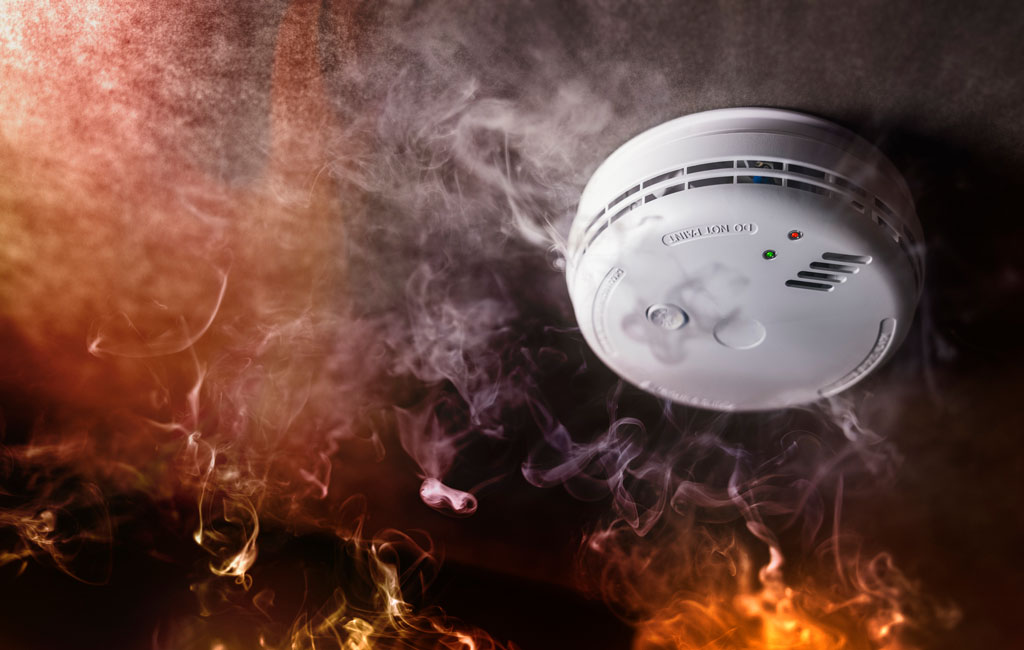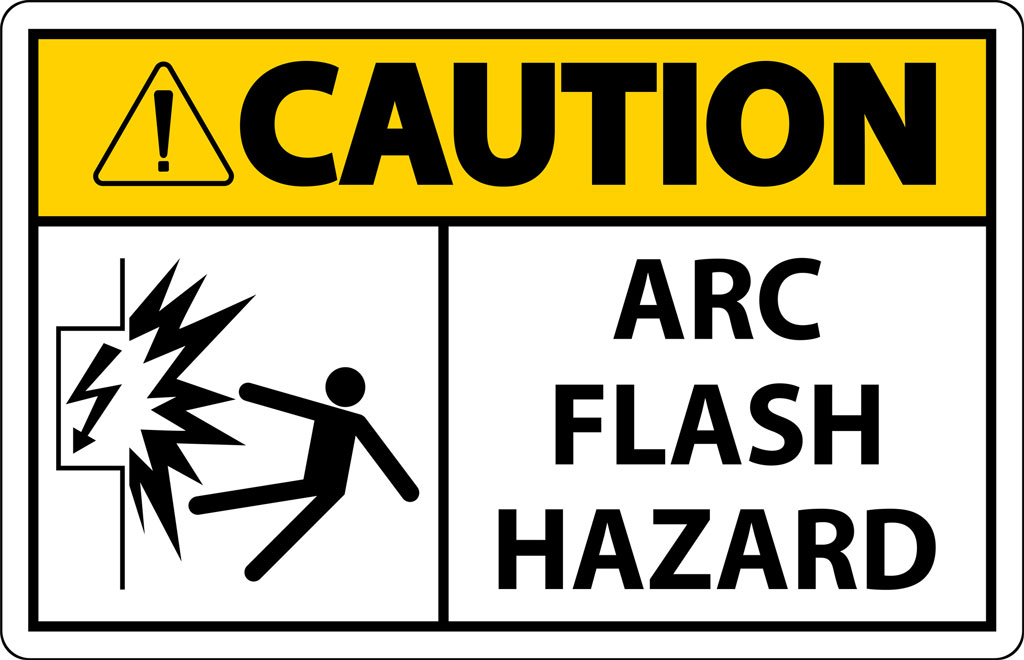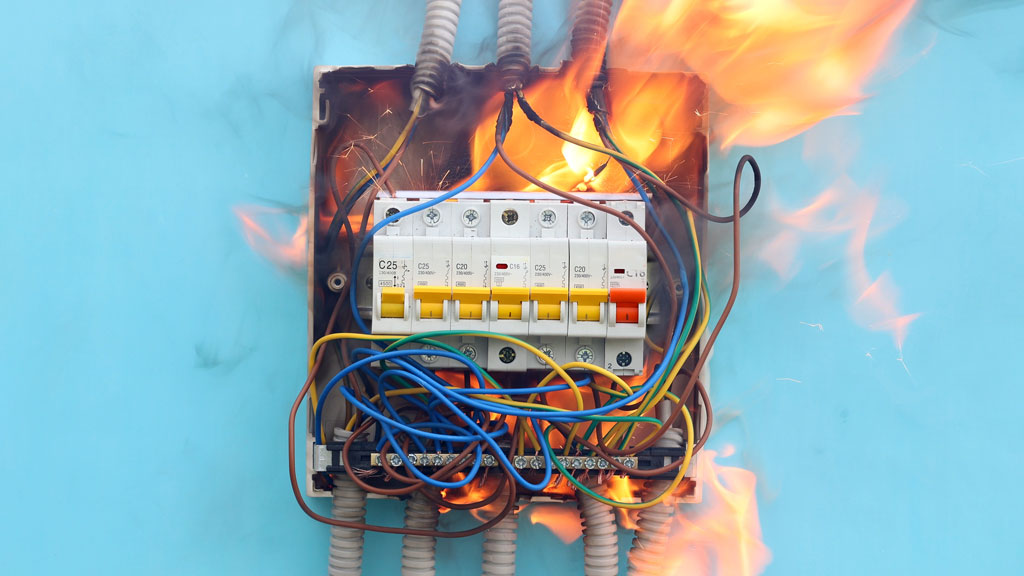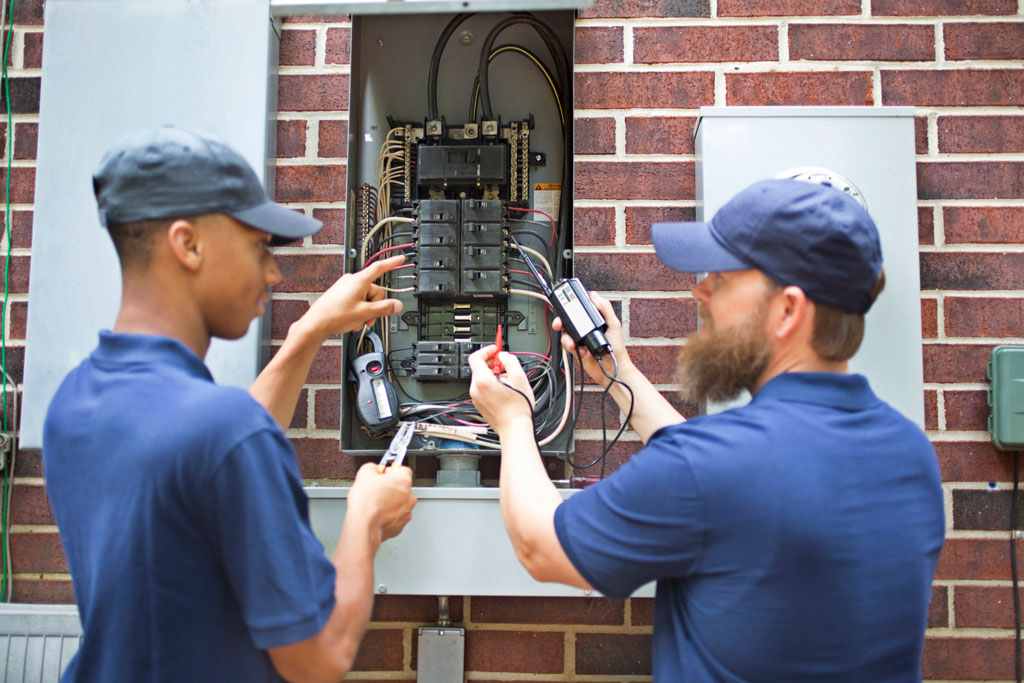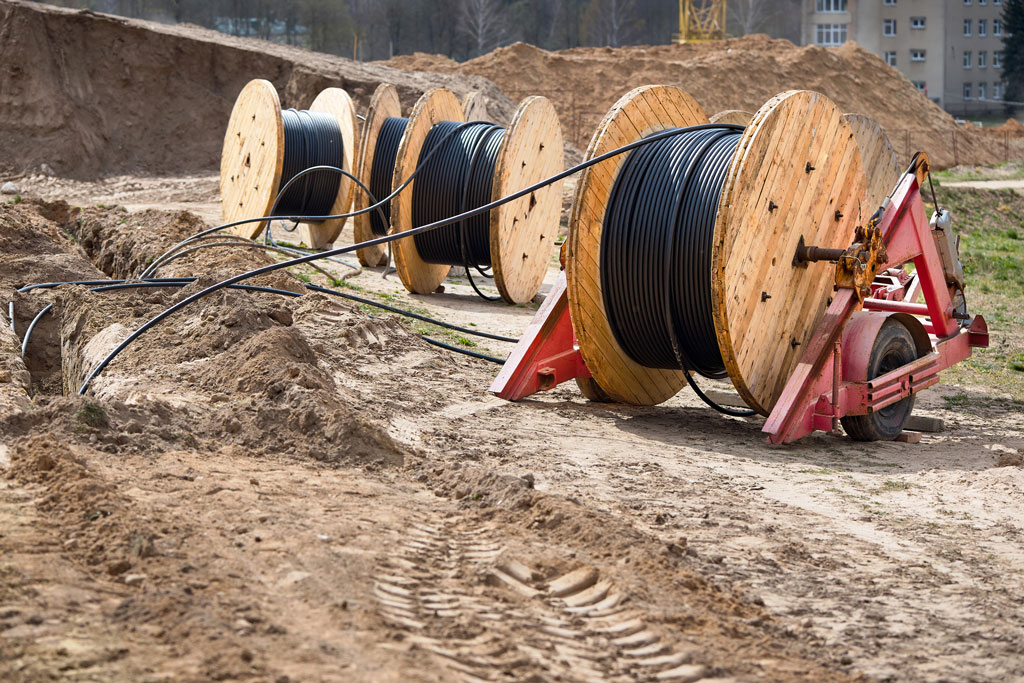
Electrician Insights: Basics of Underground Power Transmission
While most individuals are used to overhead lines or electrical wires running through their walls, power can also be transmitted underground. This is an alternative method to overhead power transmission. Undergrounding is especially necessary where overhead electric transmission is impossible or dangerous.
Transmitting power underground prevents wildfires and makes the wires less prone to outages caused by high winds, heavy snow, or thunderstorms. This blog gives a detailed overview of underground electric power transmission, including cable types, installation procedures, features, etc.
Classification Of Underground Power Cables
Cables used in underground power delivery can be classified based on several parameters, including the cable’s construction and voltage capacity. Based on voltage rating, a professional uses four types of cables for underground electrical service. They include:
- Low-tension (LT) cables with a capacity of up to 1000 V (1kV).
- High-tension (HT) cables with a maximum handling capacity of 11kV.
- Super-tension (ST) cables with a maximum capacity of 22 to 32 kV.
- Extra high-tension (EHT) cables whose rating capacity is between 33 to 66 kV.
- Extra super voltage cables with a voltage capacity beyond 132 kV.
According to the construction of the cable, an electrician can lay the following underground cables in your place:-
- Belted cables; a maximum voltage of up to 11 kV.
- Screened cables; a maximum voltage of 22 to 66 kV.
- Pressure cables; are applicable for voltages over 66 kV.
Installation Of Underground Electric Cables
Generally, qualified electrical contractors follow the following steps when installing underground power transmission in:
- Right-off-way (ROW) clearing
This is the first stage, where the electrical team identifies underground utilities and marks them before the start of underground construction.
- Blasting And Trenching
Here is where excavation starts, which involves the removal of concrete/asphalt in paved areas or the topsoil in unpaved spaces. Usually, the technician uses a backhoe to dig the trench.
Per the Occupational Safety and Health Administration (OSHA) requirements, the electrical personnel might need to shore trenches of a certain depth. Again, trench size can vary depending on the line’s voltage and cable type. Generally, the trench dimensions will be bigger in the area where a vault is located.
- Welding Pipe Or Arranging
After digging the trenches, the electrician constructs welded steel pipe sections in or over the trench. These sections house the cables.
- Vault & Duct Bank Installation
Underground cables can be encased in concrete duct banks or direct-buried. With duct bank installation, the trench is excavated further. The duct bank is assembled using conduit, spacers, and polyvinyl chloride (PVC).
Though using concrete duct banks is more expensive than the direct-bury method, most professional electrical companies recommend them for the installation of high-voltage lines.
Their construction technique offers more mechanical protection. Also, this method reduces the need for re-excavation in case of cable failure – shorter lengths of the trench can be opened at any time for construction or maintenance service.
- Cable Installation
Upon completing the vaults and duct banks, the contractor can begin to install the cables. But before cable installation starts, the conduit is cleaned by swabbing through each duct.
- Backfilling
Direct buried cables generate heat that must be carried away to operate optimally. The air accomplishes this task for overhead lines, while for underground cables, it’s the soils in and around the trench that do the work.
The choice of backfill type can significantly impact the line’s capacity rating. Remember, different soil types have varying abilities to dissipate heat.
- Site Restoration
Underground power transmission construction ends with the re-construction of any infrastructure impacted by the process, including roadways, landscaped private properties, curbs, vegetated areas, yards, and private utilities.
Distinct Features Of Underground Power Transmission
Features of underground wiring include:
- Construction
Typically, any underground cable comprises one or more conductors covered by a series of protective and insulating layers to function satisfactorily.
The construction of underground electrical lines is an aggregation of many parts necessary to safeguard against mechanical injury, corrosion, moisture, and other environmental effects. Underground cable construction is expensive because of the need for insulation and a shield.
- Conductor’s Size
One notable difference between overhead and underground cables is that the latter usually have big conductor sizes for the same amount of electrical power.
This is because underground power transmission lines have an artificial cooling mechanism, unlike the overhead cables, which have a natural cooling system, allowing them to carry more power without the risk of heating up.
- Fault Recognition And Repair
Locating faults and repairing underground cables is a relatively complex process because it takes the electrician a lot of time to find and fix problems in underground power systems.
- Heat Dissipation
The insulation and protective layers, such as sheath and armoring, allow only partial heat dissipation in underground electric power cables. Thus, most heat is maintained near the cable.
- Voltage Carrying Capacity
Due to the costly construction and limited heat dissipation, underground power transmission lines are most commonly used to transmit up to 33 kV. However, in certain circumstances, it can go up to 66 kV.
- Voltage Drop
Because of their large diameters, underground electric cables have a lower voltage drop than their overhead counterparts for the same power transmission.
- Public Safety
Underground electric transmission cables are safer for the environment, humans, and animals, unlike the overheads where people could come into contact with dangling or fallen lines.
- Interference
With underground cables, there’s no corona discharge or interference with communication lines, radio, and TV.
Let Mister Sparky of Wilmington Handle All Your Underground Wiring Needs
At Mister Sparky of Wilmington, we can address all your underground electrical service needs, from installation to repair and maintenance.
You are assured of quality services when you work with us. We have experienced electricians you can rely on even during emergencies. Buzz us right now!
In Summary
Underground power transmission might be a more reasonable alternative to overheads in suburban and urban areas where overhead construction can’t be done with proper clearance at all costs.
Weather-related outages, aesthetic issues, environmental concerns, and the high expense of some ROWs in urban settlements make underground construction more attractive. However, undergrounding is more expensive, and extreme excavation can disrupt people and street traffic.
See our most recent blog on this topic here.
Check out our reviews here.
Photo By RYosha at iStock
Preparing Your Home For Electrical Emergencies; Ways To Prevent Having To Call An Emergency Electrician
Your home is where you enjoy some happy times and shelter yourself from the rest of the world. After a long day, your home is a place that helps you relax. Therefore, to keep this much-needed haven, preparing for emergencies is vital. For instance, have a reliable emergency electrician you can call on during a breakdown or power emergency at any time. Also, it would help if you adequately prepared your household for an electrical emergency. That includes taking steps such as protecting the electrical system from electrical faults and setting aside the necessary items for an emergency. This article will highlight how you can prepare your home for an electrical emergency to help you maintain the safety and comfort of your home.
Install Surge Protectors
Protecting your electrical system is the first way to prepare your home for an electrical emergency. When an electrical fault occurs, one of the most common aftereffects in many homes is the occurrence of an electrical surge. A power surge causes a sudden current or voltage spike to flow to your home. This overcurrent can destroy or damage your electrical equipment, devices, and appliances, causing expensive repairs and needing an emergency electrician. Notably, the significant causes of power surges are lighting strikes, power grid problems, or tripped circuit breakers.
Installing surge protectors in your home will help protect your electrical circuit, equipment, appliances, and devices. This device detects a power surge and diverts it from your home into the ground. However, the efficiency of a surge protector is highly dependent on its capacity. Hence, investing in a high-quality surge protector that can satisfactorily handle your electrical load is vital. A surge protector guarantees safe power flow in your home at all times. In turn, you can enjoy family time without constantly worrying about your appliances.
Test Your Home’s Safety Devices
The safety of your home is dependent on the safety devices installed. For example, smoke and carbon monoxide detectors protect your home from fires and carbon presence in your breathing air. If your home has a carbon monoxide presence, then a CO detector alerts you, ensuring you have enough time to take preventive measures. Similarly, smoke detectors alert you to smoke in your home. Therefore, if the smoke is due to a small fire in the kitchen, you can stop in on time before it spreads. However, if a substantial fire causes smoke, you have the time to leave and call for help.
Therefore, to prepare your home for an electrical emergency, it is vital to test these devices and ensure they operate effectively. Carbon and smoke detectors should be tested at least once a month, and their batteries should be changed regularly, preferably once a year. A professional electrician can help you test these devices if you need to learn how to do so.
Avoid Overloading Your Electrical Outlets
The other helpful way to prepare your home for an electrical emergency is by using your electrical system appropriately and safely. Overloading your electrical system and outlets, such as sockets, are very dangerous. It can cause electrical fires or damage your electrical system entirely. Therefore, it is advisable to be mindful of the number of devices you plug into one socket. Instead of using one socket outlet for many devices, splitting the usage throughout the house is better. Therefore, avoid using extension cords when possible because it will give you the impression that the socket outlet is not overloaded. If your home usage is high, consider calling an installation and emergency electrician to upgrade your electrical system.
Label Your Electrical Panel
Your electrical panel has circuit breakers for different parts of your home. Therefore, labeling the breakers will make it easier to identify the different parts. Having labels will be helpful to quickly identify which circuit to turn off during an electrical emergency. Notably, preventing a catastrophic event in your home depends on your speed in cutting power supply to a part of your home. On the other hand, efficiently labeling your electrical panel can also keep you from shutting power off to crucial components in your home. It will also help you to know which section to cut power to during maintenance or when you want to change electrical appliances such as bulbs.
Have Backup Power Sources
Installing a power backup system is vital when equipping your home for an electrical emergency. During an electrical emergency, power outages are a common occurrence, especially during extreme weather conditions. This can leave your home uncomfortable due to harsh weather conditions such as freezing during winter, exposing your family to health issues like hypothermia. Therefore, consult an emergency electrician on the best backup power sources to handle your home’s power needs during a power outage for an extended period. This can range from a battery backup system to a generator. Investing in a power backup source for your home can also help prevent damage to your electrical devices, appliances, and equipment by providing a stable power source during a power outage.
Keep Emergency Supplies at Hand
When preparing your home for an electrical emergency, keeping electrical supplies where you can easily reach them is essential. They will help you not be caught off guard without a light source at night. Therefore, store supplies such as batteries, flashlights, and portable phone charges at a designated place. They will help you safely navigate your home during a blackout and even get you through the night when necessary.
An electrical emergency can rob your home of its peace and tranquility. However, effectively planning and equipping your home for these occurrences ensure you are safe and comfortable. Are you looking to install all these protective devices and learn other ways of averting electrical emergencies? Contact us at Mister Sparky of Wilmington today. Our technicians will help you emergency-proof your electrical systems to ensure peace of mind.
See our most recent blog on this topic here.
Photo By BrianAJackson at iStock
Causes of Electrical Arcing In an Electrical Panel and How an Electrician Can Help
Also called an arc flash, electrical arcing arises when electrical power discharges or flows along an unintended path and jumps to any grounded object nearby. The arc flows caused by erratic, low electrical flows commonly arise because of exposed or frayed wires and can arise anywhere in your home, including in the electric panel. The resultant electric flash is about 35 000 degrees Fahrenheit and may start an electrical fire. Hence, understanding this problem’s causes is critical to ensuring your home is safe. Fortunately, there are ways through which an electrician can help, as we’ll discuss later. However, maintenance is critical in preventing electrical arcing.
When The Panel Has An Electrical Overload
Arcing in the electrical panel arises when the circuits making up the panel are overloaded. As a result of overloading, overheating arises at the point where the electric panel bus and the circuit breaker connect. Excessive heat can damage the connection and the panel bus, making your electric panel prone to failure and unreliable. If the circuit breaker is damaged, it might not perform well when excessive electrical currents arise. Rather than trip when dangerous or excessive currents arise, the faulty circuits will continue allowing the electricity to flow. Unfortunately, this will likely cause arcing and overheating.
Contributing Electrical Panel Conditions
Another factor that could cause arcing is the conditions around or in the electrical panel. These conditions also have s significant bearing on the severity of arcing should it arise. To begin with, the electrical panel wiring should never be exposed outside the panel box. Combustible materials such as paint thinners, gasoline, papers, sawdust, and other flammable liquids shouldn’t be kept near or around the electrical panel.
Another condition that might contribute to arcing and overheating is using too many fuse units (overusing) within an electrical box. This is because they cause too much electrical power to flow via the circuitry. Have the fuses been constantly blowing, or are the circuit breakers frequently t tripping? That is a sign that the panel box may experience arcing soon. Other signs of potential arcing are a burning smell or burn marks near the panel and cracking or buzzing sounds. When you notice either, enlist an electrician for an inspection.
Faulty Electrical Panels
Faulty or damaged electrical panels can cause electrical fires or result in arcing. This was established after electrical panels produced by different manufacturers were tested in the field. For instance, electrical panels could have faulty breakers or breaker connections that could make them blow out the electrical panel’s side casings during explosions or even allow the electrical power when in the off position.
In other instances, the circuit breakers in these panels might not trip when required. Failures like these are typically considered latent hazards because although they don’t directly cause arcing, they contribute. Many of the faulty panels were produced in the 70s and earlier. If you feel your panel may be faulty, have an electrician replace it before you contend with the consequences, like electrical fires.
Preventing Electrical Panel Arcing
Arcing or arc faults are hazardous electrical problems in many homes in the US. Over 50% of the annual electrical fires can be tracked to arc faults. As mentioned above, electrical panel arc faults occur when electrical wiring suffers damage, overheating, or stress. The arc faults often result from frayed or cracked electrical wires, overloaded circuits, and outlets. Fortunately, there are some measures your reliable electrical technician can undertake to ensure that your panel box and other parts of your home are secure from arc faults.
Installing an Arc Fault Circuit Interrupter (AFCI)
The role of an AFCI is to stop overheated, overloaded, or short-circuited breakers from starting an electrical fire. AFCIs are installed in the electrical panel at your home. Arc Fault Circuit Interrupters work similarly to circuit breakers. However, they have a higher protection level and will trip and shut off the electrical power supply if they sense any dangerous arcing.
The national electrical code (NEC) is the body that established electrical standards in the United States. For all new homes and buildings, NEC requires that the circuit breaker incorporate an AFCI. So, whether a bedroom, living room, closet, dining room, or even halls, you should ensure there is an arc fault circuit interrupter.
Using an AFCI means that you can prevent the likelihood of electrical fires occurring at your home. Although it is required by law that your home have an AFCI, you shouldn’t assume they are simply there. This is particularly true if you just purchased an old home. You should call an electrician to have your home’s electrical system inspected. This is to ensure the connections are working safely and safely working.
GFCIs vs. AFCIs
Ground Fault Circuit Interrupters, or GFCIs, were introduced in the 1960s. They are installed in homes to protect homeowners and appliances from the deadly shocks that result from ground faults when using a tool or appliance. Ground faults arise when an unintentional electrical path between a grounded surface and a power source occurs.
If you or any other member of your family gets in the path of electrical flow might suffer fatal electrocution or shock. When the GFCI detects this anomaly, it cuts power to the circuit, preventing further risks. In contrast, AFCIs detect arc faults and turn the electrical power supply off, preventing possible electrical fires.
Have you noticed any signs of arcing on the electrical panel and are unsure whether there are AFCIs installed at your home? A professional should inspect the unit to ensure it is up to code. After the inspection, you will know without a doubt that you are inspected for arcing and electrical fires. Do you want your electrical system inspected? Contact us at Mister Sparky of Wilmington. Our technicians also offer electrical installation, repair, inspection, and replacement services.
See our most recent blog on this topic here.
Photo By Seetwo at iStock
Why Should You Have An Electrical Services Provider Install Arc Fault Circuit Breaker At Your Home?
The need to protect your home and those in it is an innate thought of every homeowner. Unfortunately, the electrical world can be complicated, and the constant changes in the upgrade of protection systems take a lot of work. That is why you need reliable electrical services professional to guide you through what your home needs to be secure. For example, when protecting your electrical circuit from dangers caused by factors such as overload, the many options in the market can be confusing.
What Are Arc Fault Circuit Breakers?
Arc fault circuit breakers is an electrical protection devices designed to detect electrical faults capable of causing a fire in an electrical system. Due to its detection capabilities, arc fault circuit breakers are called arc fault detection devices. When arc fault circuit breakers detect a dangerous electrical arc that can result in an electrical fire, it cuts the flow of electricity to the premises. Therefore, these protection devices have become increasingly popular in most homes and businesses since they guarantee safety against electrical failure.
Why Were Fault Circuit Breakers Created?
Before the creation of these protection devices, there was a severe problem of electrical fires in many homes. Arc fault circuit breakers curb the number of fires in homes. However, even with the creation of arc fault circuit breakers, statistics indicate that there are still many electrical fires. These fires cause property damage and result in civilian deaths. Thus, you should have electrical services professional install an AFCB to protect you and your family against electrical fire.
How Do Arc Fault Circuit Breakers Work?
An electrical arc is one of the most naturally occurring in a home. It is triggered by an appliance’s operation or even lighting a switch. Therefore, to curb the potentially hazardous effects of an electric arc, arc fault circuit breakers monitor the electrical flow in your home to detect any unusual arcing conditions. The arc fault circuit breaker has a logic circuit and small filters that act as smart instruments enabling the breaker to pick up any change in the flow of electricity in your home. If the device detects a suspicious arching in your electrical system, it cuts off electricity flow to protect your home from a fire.
Arc fault circuit breaker’s operation differs from other circuit-breaking devices. While the arc fault circuit breaker’s design is to detect any potentially dangerous arching in the electrical system, standard circuit breakers only protect the electrical circuit from overload, short circuits, and current leakages. Arc fault circuit breakers ensure your home’s current flow is uninterrupted from the source to your appliances. However, when it notices a change in the system, the breaker prevents possible damage by opening the circuit. Therefore, even with standard circuit breakers in your home, incorporating arc fault circuit breakers is advisable since they increase electrical safety. Some AFCB models have combined protection capabilities against short circuits, overload, fault detection, and leakage protection.
Which Arcs Can an AFCB Detect?
Several types of AFCBs an electrical services provider may install at your home. Although these electrical protection devices have different types of technologies depending on the model and manufacturing company, arc fault circuit breakers can detect two types of arcs in an electrical circuit; parallel arcs and series arcs. A parallel arc can be between line-to-line, line-to-ground, and line-to-neutral arcs. On the other hand, series arcs are in series with the same electrical conductor.
Are Conventional Circuit Breakers Adequate?
In most homes, electrical arcs are usually small fluctuations in the current flow. However, these fluctuations differ from large currents that go to the ground, like in most overloading or short-circuit cases. Consequently, they can generate enough heat to ignite surrounding materials in the house.
The main issue with conventional circuit breakers is that they do not detect these small current fluctuations, unlike arc fault circuit breakers. They only notice large current flow generated by faults such as short circuits. Therefore, if you equip your home with these conventional circuit breakers alone, they are inadequate in detecting small currents that can lead to electrical fires leaving your home vulnerable to these occurrences.
Benefits of Arc Fault Circuit Breakers
Arc fault circuit breakers have integrated sensor technology that detects arcing events in your electrical circuit. Therefore, it is well suited to protect your home from electrical fires since detecting a potentially dangerous arcing; shuts off electricity flow.
Notably, since these circuit breakers can tell between a normal arc and a dangerous one, they do not trip every time an arc occurs. This is an added advantage since many devices and electrical appliances in an electrical system continuously generate electrical arcs, which are not dangerous. Therefore, arc fault circuit breakers will continuously analyze the arcs in your installation, determining if they are dangerous or safe for your home.
In addition, some arc fault circuit breakers can also protect against short circuits, overload, fault detection, and leakage protection. Therefore, it is adequate to operate as the central protection device for your home, unlike conventional circuit breakers, which will need you to incorporate an AFDB.
Moreover, installing arc fault circuit breakers is relatively easy and can be installed by the electrical services provider in any room in your home. Another advantage of arc fault circuit breakers is that they are available in different models and types. Some models have advanced features such as leakage protection, short circuit, and arc fault detection. Some models can also be used for infrequent switching of your circuit.
The safety of your home is vital. Therefore, an AFDB is an excellent addition to your home. This circuit breaker will protect your home from electrical fires by cutting the power supply to your electrical circuit when it detects dangerous electrical arcs. Do you need to replace or install one at your home? Contact us at Mister Sparky of Wilmington for a professional installation.
See our most recent blog on this topic here.
Photo By Grigorev_Vladimir at iStock
When To Call An Electrician For An Electrical Panel Upgrade
Electrical panels are essential components in our home’s electrical system but are often overlooked until an electrical problem arises. They protect electrical circuits from overload and reduce electrical fires.
If you live in an old house, there is a good chance your electrical panel is outdated and needs an upgrade. Upgrading your electrical panel increases the safety of your home wiring and gives your home appliances a higher amperage rating.
When upgrading your electrical panel, it is crucial to ensure experienced professionals carry out the job to minimize the risk of accidents and further damage. This article explores what signs indicate that an upgrade is necessary.
Outdated Fuse Panels
Although fuses may not be entirely dangerous, they are more susceptible to fire hazards if outdated. They may also not provide adequate protection against overloading and short circuits when they reach the end of their lifespan.
Fuse panels have a restricted capability and cannot handle the electrical demands of modern appliances and electronics. This could lead to frequently blown fuses or tripped circuits, which can be frustrating and inconvenient.
Even insurance companies refuse to provide coverage for homes that rely entirely on fuses for their electrical systems. If you have an outdated fuse panel, consider contacting an electrician to upgrade your electrical panels to the appropriate size and type to meet your home’s needs.
This investment will not only provide the peace of mind you need knowing your home and belongings are safe but also ensure that your family is safe.
Excessive Use Of Power Extension Cords and Strips
Most homeowners may require more power outlets to meet the electrical demands of their devices and appliances, such as televisions and appliances, computers, and heaters. In such situations, power cords and strips may seem convenient.
However, it is important to remember that these devices are not designed for long-term use and can pose a safety hazard if not used in moderation. It is recommended that you limit their use to temporary situations only.
Also, the greater the number of devices and appliances connected to power cords and strips, the higher the homes’ electricity leading to higher energy bills.
If you require power strips frequently to accommodate the electrical demands of your household, consider upgrading your electrical panel. This will ensure a safer and more reliable power supply.
Obsolete Electrical Wiring In Your Home
Outdated wiring in your home can pose a safety hazard and require an upgrade. There are various indicators that your home has obsolete electrical wiring, including lights fading or dimming, blackened outlets, electrical shocks, and burning smells around electronics.
If you detect any of these signs, it is wise to consult a licensed electrician and arrange to update your wiring and electrical panel. Remember to prioritize safety when it comes to your home’s electrical system.
Frequent Power Outages
Frequent power outages may be an indication of an overloaded electrical circuit. When there is a high demand for electrical power in your home exceeding the electrical panel capacity, the circuit breaker trips. Thus, cutting off power to that circuit to prevent damage to appliances and potential fire hazards.
Sometimes the power outages may be from aging electrical panels due to faults or malfunctions. If you frequently experience power outages in specific parts of the building, contacting a professional to inspect your electrical panel would be crucial.
And based on their analysis, they may recommend an electrical upgrade to handle your home’s power demand.
Insufficient AMPS
The amount of power required by modern homes has increased over the years. Older electrical panels are used between 30 to 60-amps, which may no longer be adequate to handle the increased electrical demand from modern devices and appliances.
According to Electrical Safety Foundation International (ESF), modern homes require 100 to 200 AMP service panels to provide safety and protection. Modern homes have multiple large appliances such as refrigerators, washing machines, dryers, and ovens.
These require significant power and exceed the power of the older electrical panels, leading to power issues.
Upgrading to a 200-amp electrical panel will not only provide a more reliable and efficient electrical system but also provides capacity for future upgrades.
Renovations At Your Home
If you are renovating your home and adding new electrical appliances, consider how they will impact your electrical panel. Many older electrical panels are not designed to handle the increased electrical load of modern appliances and technology.
For instance, if you buy a new air conditioning unit or install a high-quality kitchen appliance like an induction stove, your existing electrical panel may not manage the additional load. This will lead to frequent power outages or tripped breakers.
Under those circumstances, upgrading your electrical panel becomes vital to ensure the safety and efficient operation of your electrical systems.
Moreover, upgrading your electrical panel during renovations is also an opportunity to ensure your home’s wiring and electrical systems are up-to-date and comply with modern safety codes and standards.
Need An Upgrade For Your Electrical Panel?
Are you experiencing any electrical issues at home or want to learn more about electrical panels and get a suitable upgrade for your home? As your trusted electrician, Mister Sparky of Wilmington is here to help. We provide inspections, residential and commercial electrical services, professional lighting, and generator repairs.
Our team of certified technicians is committed to providing superior, safe, and reliable electrical solutions to meet your needs. Don’t hesitate to contact us today to schedule an appointment.
In A Nutshell!
Overall, upgrading your electrical panel maintains the safety and functionality of your home’s electrical system. Feel free to contact a licensed electrician if you experience any of the signs mentioned above to perform inspections and assess the situation.
See our most recent blog on this topic here.
Photo By fstop123 at iStock
Check out this tip!


